About 40-80% of people complain that the spine in the lumbar region hurts, but no more than 25% of them seek medical help. In fact, such unpleasant sensations can be caused by both relatively harmless reasons and pathological changes in the spine. Therefore, you should not treat them scornfully.
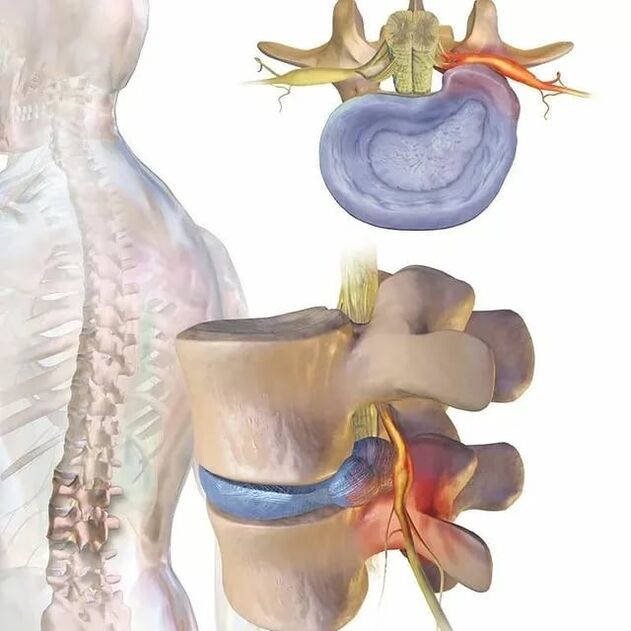
Causes of back pain
The spine consists of a whole complex of structural elements: bones, joints, intervertebral discs, ligaments, nerves. Changes in any of them can be accompanied by painful sensations, and of a different nature. In addition, the spinal column is surrounded by the paravertebral muscles, pain in which patients often confuse with pain in the spine. Thus, there can be many reasons for the occurrence of pain. It can be overwork, a natural restructuring of the body during pregnancy, etc. But if pain occurs regularly, you should contact a vertebrologist or neurologist, as often the fact that the spine systematically hurts in the lumbar region indicates the development of certain diseases.
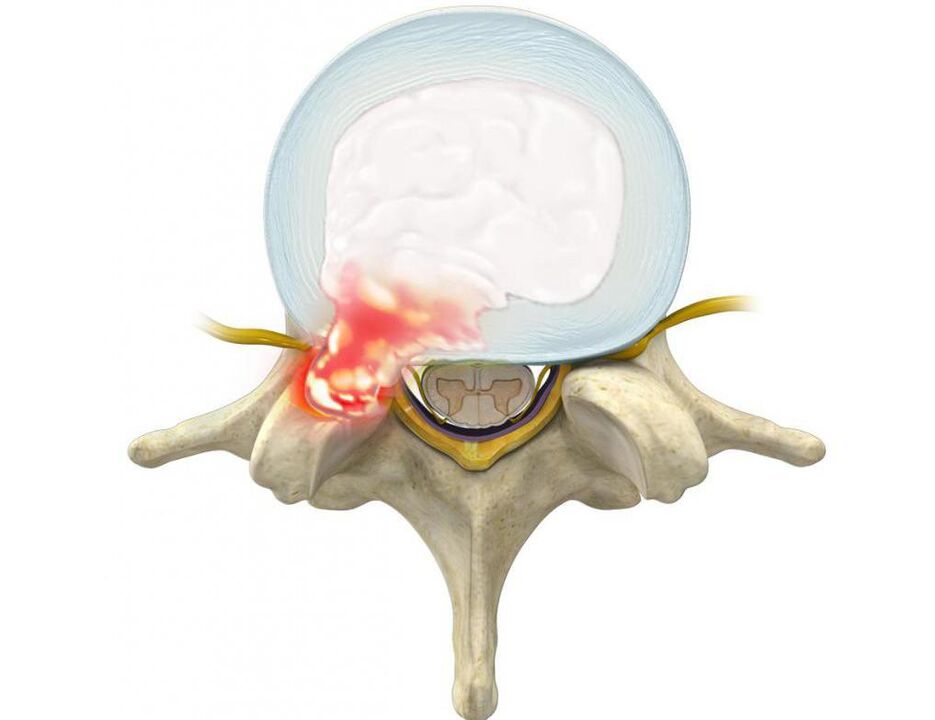
Most often, in such situations, patients are diagnosed with:
- pathology of intervertebral discs (decreased disc height, protrusion, intervertebral hernia, discitis);
- facet joint pathologies (spondyloarthrosis, joint cysts);
- inflammatory diseases (ankylosing spondylitis or ankylosing spondylitis, reactive arthritis, psoriatic arthritis)
- compression fractures of the vertebrae against the background of osteoporosis;
- neoplastic lesions of the spine.
Intervertebral disc pathologies
Degenerative changes in the intervertebral discs or osteochondrosis are very common, especially among young and middle-aged people. This is largely due to the need to sit for a long time or engage in heavy physical labor. In old age, the disc dries up and the vertebrae grow together.
Already at the initial stages of the onset of degenerative changes in the intervertebral discs, which are cartilages of a special configuration dividing the vertebral bodies, pain in the spine may occur. This is due to irritation of the pain receptors of the outer layers of the disc, as well as the posterior longitudinal ligament of the spine. Often, osteochondrosis provokes an aseptic inflammatory process, which leads to a reflex spasm of segmental muscles. As a result, the pain in the spine increases, and there are also restrictions on mobility.
Osteochondrosis tends to constantly progress, especially in the absence of appropriate treatment and lifestyle correction. Subsequently, it leads to the formation of protrusions, and later on intervertebral hernias, which provokes the aggravation of existing symptoms and the appearance of new ones.
The lumbar region, due to the fact that it carries the highest loads in daily activities, is most often affected.
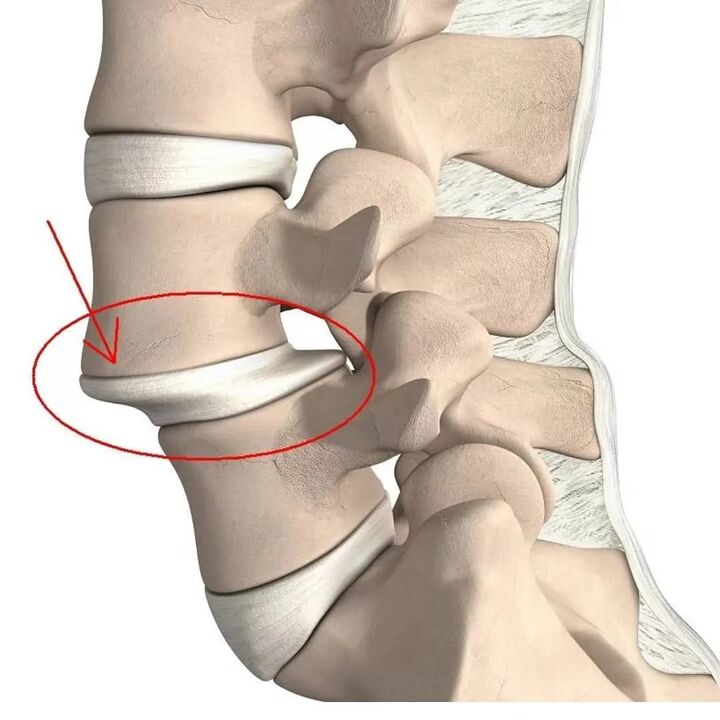
Protrusions are protrusions of the disc while maintaining the integrity of its outer shell, called the annulus fibrosus. While maintaining the influence of provoking factors over time, the fibers of the annulus fibrosus do not withstand the load and pressure of the inner contents of the disc (nucleus pulposus) and rupture. As a result, the nucleus goes beyond the physiological position of the intervertebral disc. At the same time, the spine in the lumbar region always hurts or the pain radiates to the leg, and the discomfort increases with sudden movements, bending, lifting heavy objects, straining, coughing, sneezing, laughing, as well as with prolonged sitting in one position, walking, standing.
Often, patients with already formed protrusions and hernias unconsciously assume a forced posture, leaning slightly towards the healthy side. In this case, pain in the spine in the lumbar region can reach high intensity, depriving a person of working capacity. In such cases, he is forced to adhere to bed rest, and to relieve pain, he tightens the leg bent and brought to the stomach.
Most often, protrusions and hernias form in the direction of the spinal canal, in which the spinal cord (cauda equina) and the nerve roots branching from it pass. The latter pass through the natural openings in the vertebral bodies and further branch into the lumbar plexus, which is responsible for the innervation of the lower extremities and various organs (including the genitals).
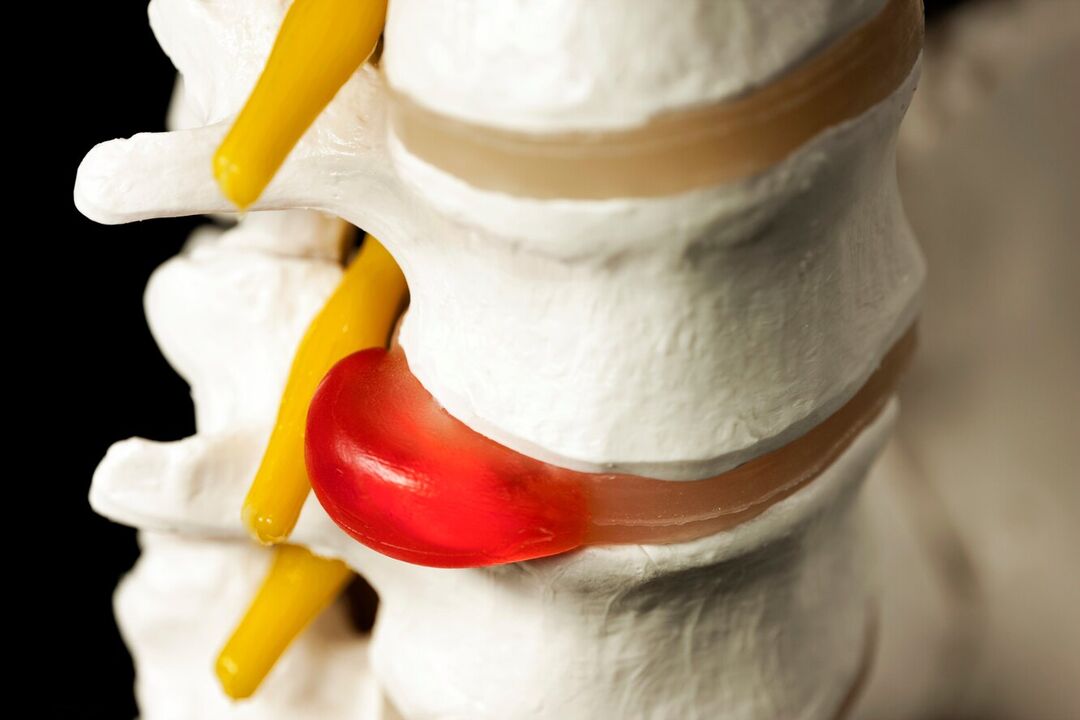
Therefore, often with long-term osteochondrosis, the formation of hernias in the lumbar region, pain in the spine is gradually not only intensified, but also supplemented by other disorders. If a deformed disc or soft tissues swollen due to an inflammatory process squeeze the spinal root passing near them, neurological disorders occur. Therefore, pain in the spine in the lumbar region can be supplemented by radiating to the buttocks, groin, front, inner, outer thigh, lower leg and foot. It depends on what kind of nerve root will be impaired, that is, at the level of which spinal motion segment pathological changes will be observed. Also, in the corresponding zones of the lower extremities, sensitivity disorders can be observed in the form of a feeling of crawling, numbness, changes in susceptibility to temperature, pain, tactile stimuli and limited mobility.
Changes in the height and functionality of the discs arising in osteochondrosis and its complications lead to damage to the articular apparatus of the spine, as well as degeneration of the vertebral bodies themselves. The consequence of this is the development of spondylosis, i. e. calcification of the anterior longitudinal ligament and the formation of bone-cartilaginous growths on the surface of the vertebral bodies (osteophytes). They can not only injure the surrounding tissues and squeeze the spinal roots, causing severe pain in the spine, but also grow together. As a result, adjacent vertebral bodies are combined into a single whole, which sharply limits the mobility in the lower back.
Osteochondrosis can be accompanied by reactive changes in the vertebral bodies, in particular, reactive aseptic spondylitis, leading to osteosclerosis. This is accompanied by compaction of bone tissue and dramatically increases the likelihood of vertebral fractures.
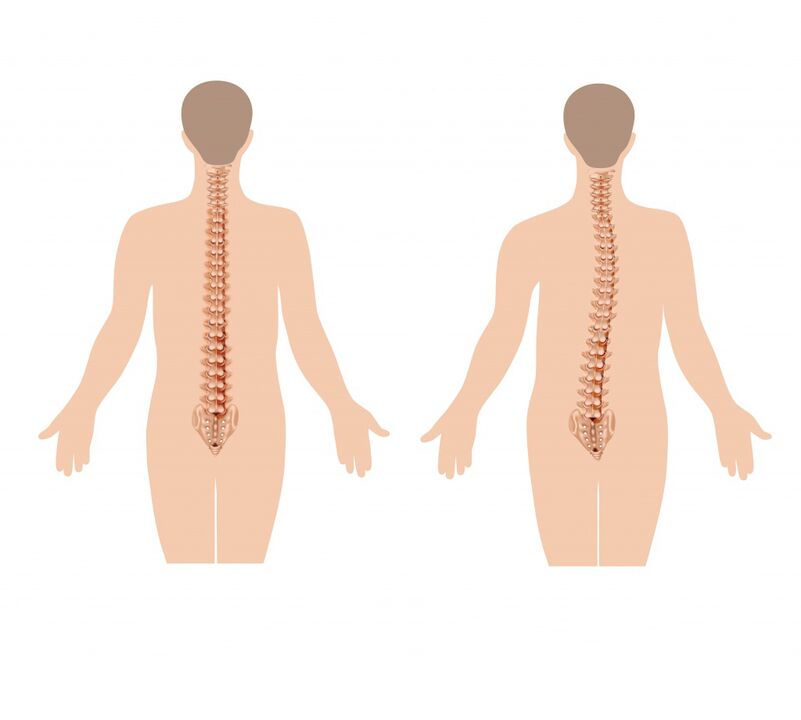
Facet joint diseases
Pathologies of the facet or facet joints of the lumbar spine, in particular their arthrosis, can also cause pain in the spine in the lumbar region, including severe pain. Although more often the pain is aching and localized deep inside. Their appearance is due to the fact that their synovial capsule is richly innervated. In such situations, the pain is usually concentrated directly in the affected area and tends to increase with bending, extension, turning the body, prolonged standing. Walking and sitting help reduce their severity. But in some cases, pain can also be given to the groin area, coccyx, as well as the back and outer thighs.

Inflammatory diseases of the spine
Inflammatory diseases of the spine are less common than pathologies of the intervertebral discs and facet joints. However, they also hurt the spine. These include:
- ankylosing spondylitis or ankylosing spondylitis;
- reactive arthritis;
- psoriatic arthritis, etc.
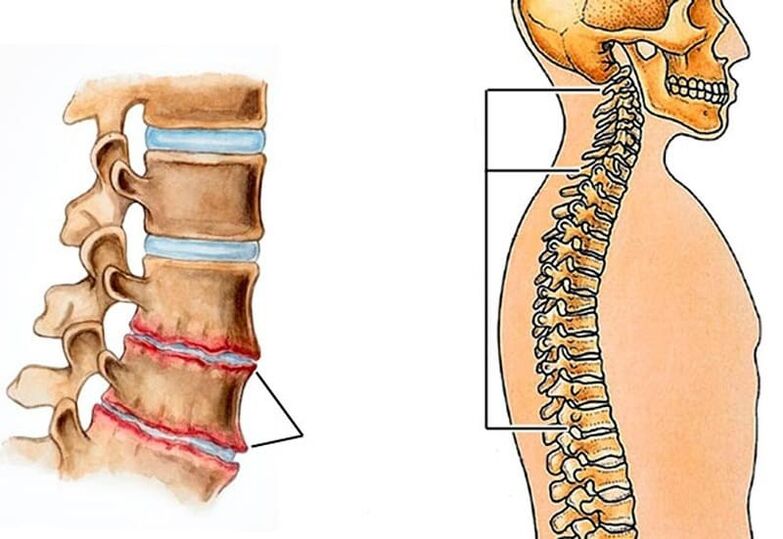
Symptoms of these diseases usually occur before the age of 40, and more often at the age of 20. This distinguishes them from degenerative-dystrophic pathologies of the discs and joints of the spine, which often develop after 40 years. In this case, the pain is characterized by a gradual increase in intensity. Moreover, their severity decreases after physical exertion, but does not decrease at rest. Therefore, in inflammatory diseases, the spine in the lumbar region often hurts at night and is especially severe in the morning, immediately after sleep.
The most difficult situation is observed with ankylosing spondylitis, and it is she who more often than other inflammatory diseases affects the lumbar region. This term means inflammation of the intervertebral joints with their subsequent immobilization due to the formation of dense bone, cartilaginous or fibrous fusion between the articulating bone structures.
At first, it is characterized by mild back pain, but over time they gradually spread higher, covering the thoracic and then the cervical spine. This is associated with the development of limitation of the mobility of the spine in all planes, since the spinal column, as a result of the changes taking place, seems to be immersed in a specific case. Also observed:
- alignment of lumbar lordosis (natural curvature of the spine in the lumbar region);
- aggravation of thoracic kyphosis, which provokes stoop;
- reflex tension of the back muscles;
- progressive aggravation of limitation of mobility due to the involvement of facet joints in the pathological process and ossification of intervertebral discs;
- morning stiffness for an hour or more.
In 10-50% of patients, inflammation of the iris (iritis), cornea (keratitis), mucous membrane (conjunctivitis), iris and ciliary body of the eyeball (iridocyclitis) is observed.
The progression of ankylosing spondylitis leads to the fact that an increasing number of joints in the pathological process. As a result, patients are forced to acquire the so-called supplicant pose. It means pronounced kyphosis of the thoracic spine, tilt of the upper body downward, bending of the knees with a sharp limitation of the range of motion in the chest, which affects the depth of breathing.
The rate of progression of the disease depends on the adequacy and completeness of the treatment.
Compression fracture of the vertebra
Compression fracture is the flattening of the vertebral body, as a result of which it becomes wedge-shaped. This leads to disruption of the anatomy of the spine, can provoke trauma to the spinal cord and its roots, and also become a triggering factor for the rapid progression of degenerative-dystrophic changes.
The lumbar vertebrae 1 and 2 are more susceptible to injury, since they take on the greatest axial load.
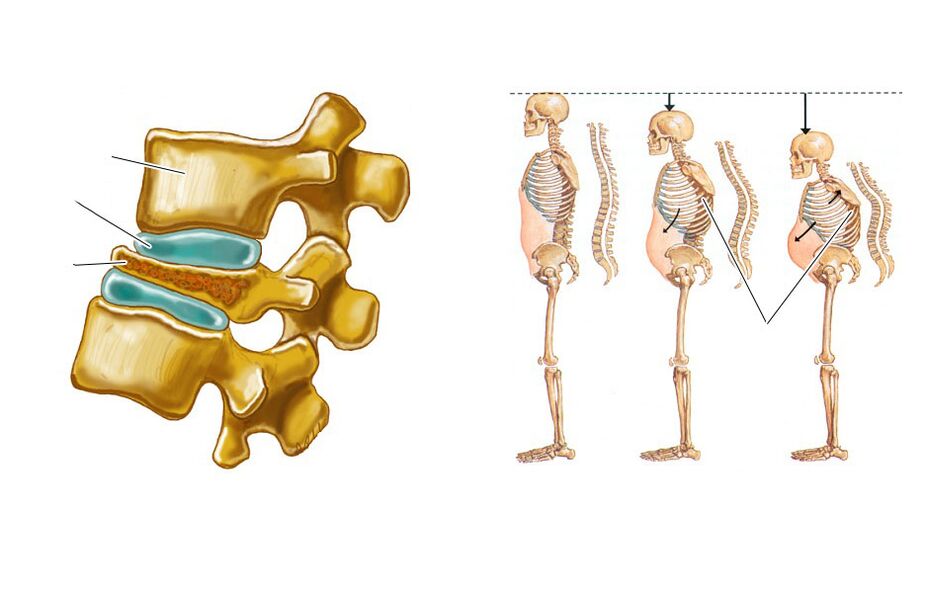
Compression fractures of the spine often occur in the elderly due to the development of osteoporosis, i. e. , a decrease in bone density. In such cases, to get injured, it may be enough not only a slight fall, but also lifting weights, an unsuccessful movement.
Pathology is characterized by the presence of pain in the spine, which restricts movement, increases with sitting, movement and attempts to raise a straight leg up. It usually lasts 1-2 weeks and then gradually decreases over 2-3 months. In some cases, there is irradiation of pain in the crests of the iliac bones and hips. A decrease in the height of a broken vertebra provokes an increase in lumbar lordosis, which also contributes to the occurrence of painful sensations.
If a fracture is not diagnosed in a timely manner, a decrease in the height of the vertebra leads to changes in posture, a decrease in growth. This provokes reflex tension and shortening of the muscles in the spine, which causes chronic back pain and necessitates prolonged rest.
Spinal neoplastic lesions
Neoplastic lesions of the spine mean the formation of benign and malignant tumors in it, as well as metastases, the source of which are neoplasms of other organs. This is much less common than pathologies of intervertebral discs, facet joints, ankylosing spondylitis, and even compression fractures, namely only in 1-2% of patients with back pain. But such lesions require the earliest possible diagnosis and treatment.
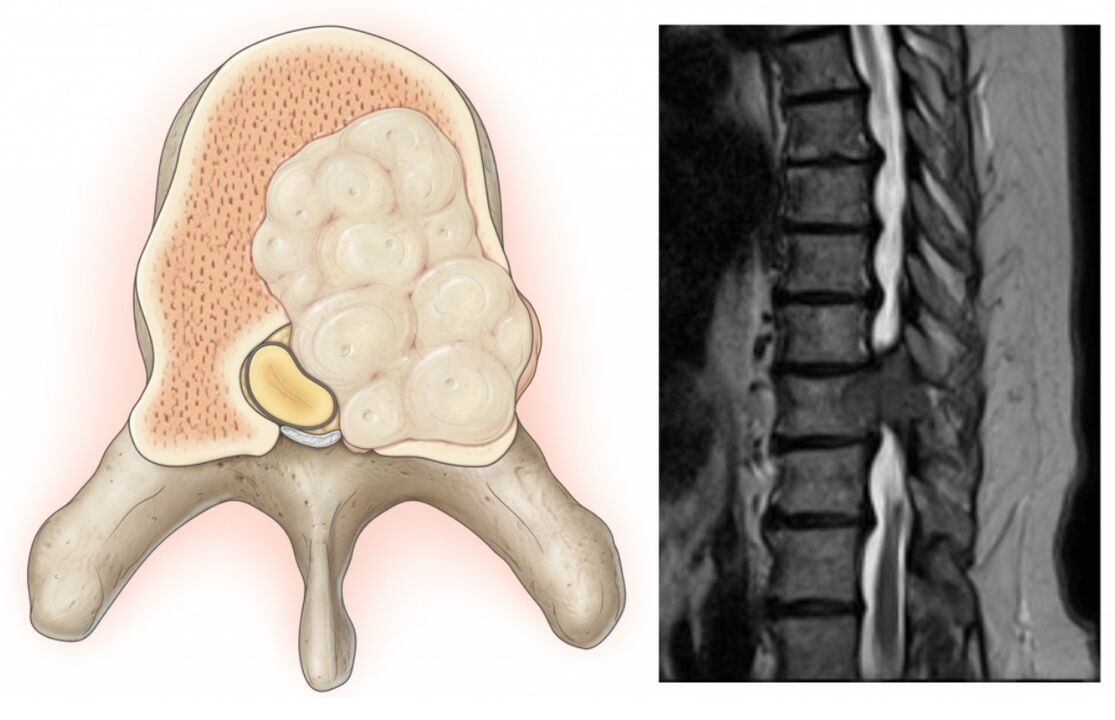
The characteristic features of neoplastic lesions of the spine, in addition to pain in it, are:
- an increase in body temperature, including up to subfebrile values;
- unreasonable weight loss;
- inability to find a comfortable body position;
- the presence of pain at night;
- severe pain in the spinal column;
- inability to relieve pain syndrome with conventional analgesics.
Even if you have 1 or 2 of these symptoms, you should make an appointment with your doctor immediately.
In a similar way, the following may appear:
- Chondroma is a malignant tumor diagnosed in 20% of patients with cancerous lesions of the spine. Most often it forms in the sacrum and can occur in people of any age and gender.
- Young's sarcoma - occurs in 8% of patients with neoplastic lesions of the spine. More common in young men.
- Chondrosarcoma is a malignant neoplasm, which accounts for 7-12% of cases. It is more often found in middle-aged men.
- Aneurysmal bone cyst is a benign neoplasm.
- Hemangioma is a benign vascular tumor that is present in 11% of people. It may not be detected throughout a person's life. But it increases the risk of vertebral fractures.
- Metastases of other tumors are secondary malignant neoplasms. More often, cancer of the breast, prostate, lungs, and less often of the kidneys, thyroid gland and skin metastasizes to the spine.
Diagnostics
If the spine in the lumbar region hurts, it is worth making an appointment with a neurologist or vertebrologist. At the appointment, the doctor initially collects an anamnesis, asking questions about the nature of the pain, the circumstances of its occurrence, the duration of its persistence, the presence of other symptoms, lifestyle, etc.
Then the specialist conducts an examination. Within the framework of it, he not only palpates the spine, determines the localization of pain, assesses the gait and posture that the patient takes unconsciously, but also conducts functional tests. With their help, you can detect signs of ankylosing spondylitis, neurological deficit, assess the degree of mobility of the spine and obtain other diagnostic data.
Based on this, the doctor can already assume the possible causes of the pain syndrome. To clarify them, as well as to accurately determine the degree of damage, instrumental and sometimes laboratory diagnostic methods are additionally prescribed. Most often they resort to help:
- radiography in frontal and lateral projection, sometimes with functional radiological tests;
- CT - allows better visualization of bone structures, therefore it is more often used to diagnose spondylosis, fractures, bone tumors, etc. ;
- MRI - makes it possible to assess the condition of cartilaginous structures and soft tissues as scrupulously as possible, therefore it is more often used to diagnose osteochondrosis, protrusions, intervertebral hernias, spinal cord lesions, etc. ;
- electromyography - indicated for neurological disorders of unknown origin, as well as for assessing the degree of nerve damage;
- radioisotope bone scintigraphy - used to diagnose malignant tumors and metastases;
- X-ray densitometry is the best method for diagnosing osteoporosis;
- myelography - used to detect signs of compression of the spinal cord and nerves of the cauda equina.
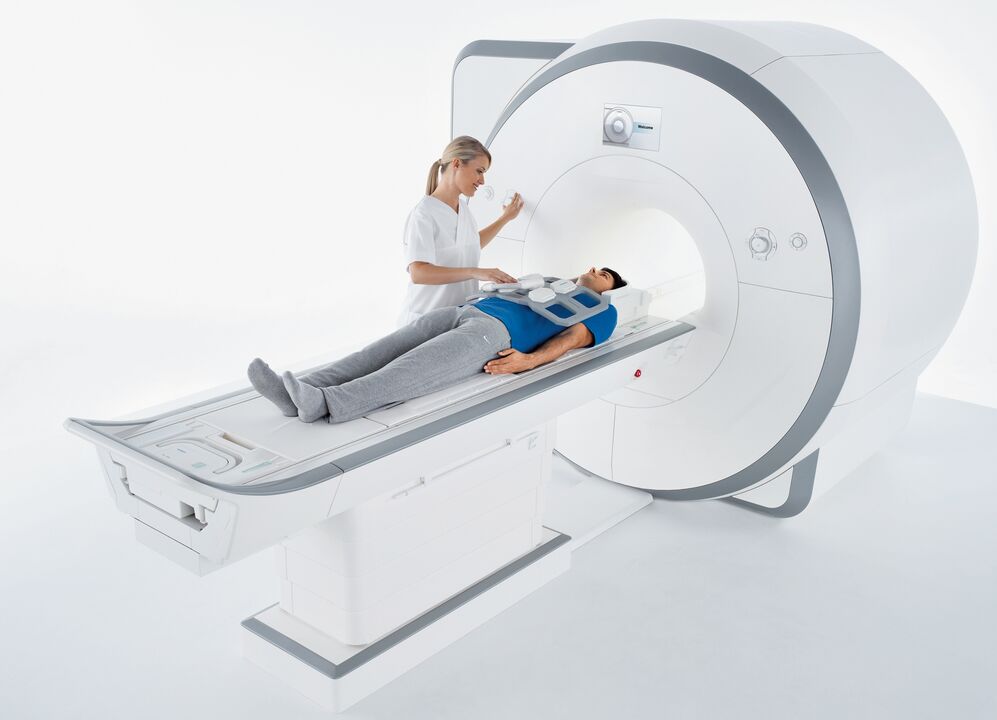
Treatment
For each patient, treatment is selected strictly on an individual basis, and not only on the basis of the diagnosis, but also the nature of the existing concomitant pathologies. Nevertheless, it is the cause of back pain that determines the tactics of therapy. It can be conservative or involve surgical intervention.
But the first step is always to direct efforts to relieve pain, especially if it is strong. For this, patients are prescribed NSAIDs, antispasmodics, pain relievers. And in severe cases, spinal blockages are performed - injections of anesthetics and corticosteroids at specific points in the spine.
Bed rest is not shown to all patients. And with pathologies of intervertebral discs, it may be completely contraindicated, since a decrease in physical activity contributes to the transformation of acute pain in the spine into chronic pain.
Exclusively conservative or non-surgical treatment is prescribed for:
- osteochondrosis;
- ankylosing spondylitis;
- arthrosis of the facet joints;
- light compression fractures.
It is usually complex and consists of:
- drug therapy, which may include NSAIDs, chondroprotectors, muscle relaxants, immunosuppressants, corticosteroids,
- physiotherapy (UHF, magnetotherapy, laser therapy, traction therapy, etc. );
- Exercise therapy;
- manual therapy.

If the cause of back pain is intervertebral hernias, protrusions, spondylosis, severe vertebral fractures, tumors, surgery is often indicated. It is also necessary for:
- ineffectiveness of conservative therapy for degenerative-dystrophic changes;
- an increase in neurological deficit;
- instability of the spinal motion segment;
- the development of complications, in particular stenosis of the spinal canal.
Most modern spinal surgeries are minimally invasive. Thanks to this, intraoperative and postoperative risks are sharply reduced, the rehabilitation period is shortened and facilitated, and the effectiveness is not inferior to more traumatic open operations. Depending on the detected disease, it may be recommended:
- Discectomy is an operation indicated mainly for hernias and protrusions, especially those provoking cauda equina syndrome. It can be performed using microsurgical instruments through an incision of the order of 3 cm (microdiscectomy) and using endoscopic equipment supplied to the spine through puncture punctures with a diameter of about 1 cm (endoscopic discectomy). When the intervertebral disc is completely removed, it is usually replaced with implants.
- Vertebroplasty and kyphoplasty - indicated for compression fractures of the vertebrae, hemangiomas and some other diseases. The essence of the operation is to inject rapidly hardening bone cement through a thin cannula into the vertebral body, which strengthens it. With kyphoplasty, it is additionally possible to restore the normal dimensions of the vertebral body, which is important in case of a serious decrease in their height as a result of a fracture.
- Fixation surgeries are used to stabilize the spinal column. For this, metal structures of a different nature are used, which usually remain in the patient's body until the end of life.
Thus, the spine in the lumbar region can hurt for a variety of reasons. Therefore, with prolonged persistence of painful sensations, their regular occurrence, increased pain over time, and even more the addition of other symptoms, it is imperative to contact a vertebrologist or neurologist. Early diagnosis will make it possible to detect pathological changes at the stages when it is easiest to cope with them and if the disease is not completely cured, then at least stop its progression and maintain a high standard of living.












































